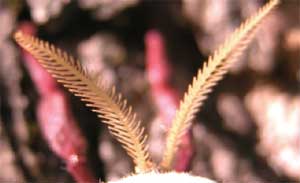Olfactory orientation
Objectives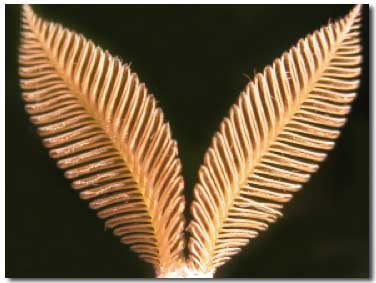
At the end of this topic you should be able to:
- understand and explain the role of olfactory orientation in an insect’s life-cycle
- understand and explain the behavioural mechanisms of orientation
- appreciate the importance of olfactory orientation to the success of insects
- illustrate your understanding using your own example from the diversity of insects
Topic outline
- Part 1: Precursors to orientation – perception and context
- Part 2: Behavioural mechanisms – taxis and kinesis
- Part 3: Plasticity, learning and evolution
Activities
- Minilecture on navigation by odours.
- Part 2: 2 videos on odour plumes
- Part 3: read the biotechniques article, and related references
- glossary links included at the end of each page
Part 1: Overview and precursors to orientation
Orientation is a behavioural device that allows an insect to achieve a particular spatial relationship with aspects of its environment. Essential to the survival of insects is the ability to locate and orientate to resources such as food and mates. The ability to locate specific external resources at and only at the most appropriate time in their life cycle ensures the most efficient use of an insect’s internal resources. Olfactory orientation is generally used for medium to longer-range movement toward an odour source. Other senses such as gustation and vision are used more often for short-range orientation and acceptance of the resource.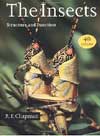
This topic follows on directly from the module explaining olfaction and gustation. Review Chapman Section 24, pp 636-645.
|
download video file (m4v) 312MB |
Precursors to orientation – perception and context.
In the previous topic, we learnt how insects perceive olfactory stimuli. In this topic, we will explore how insects use olfactory stimuli to locate the resources they need. Olfactory stimuli, or odours, are generally volatile chemicals that can be adsorbed into the olfactory sensilla and stimulate the receptors within. The environment is teaming with odours, but only a subset of these can be perceived by insects. Insects usually become sensitive to odours only when such stimuli are relevant to their particular stage of the life-cycle.
Sensitivity:
Female Aedes aegypti mosquitoes become sensitive to human odours only when they are ready to take a blood meal (at least 3 days old). Mosquito ORNs sensitive to the host chemical lactic acid (from skin emanations) are tuned down after a blood meal.
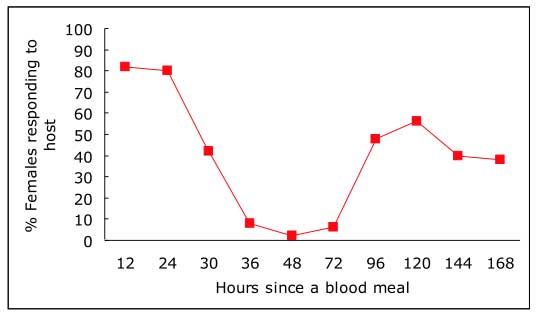
The percentage of inseminated Aedes aegypti responding to a host after a 1µl blood enema at 0hr. (Redrawn from Klowden MJ and Lea AO (1979) Humoral inhibition of host-seeking in Aedes aegypti during o?cyte maturation. Journal of Insect Physiology, 25: 231-235)
Gravid females stop orienting to host odours and become sensitive to the odours from water-filled containers where they can lay their eggs. Females mosquitoes also exhibit a circadian rhythm in their response to host odours.
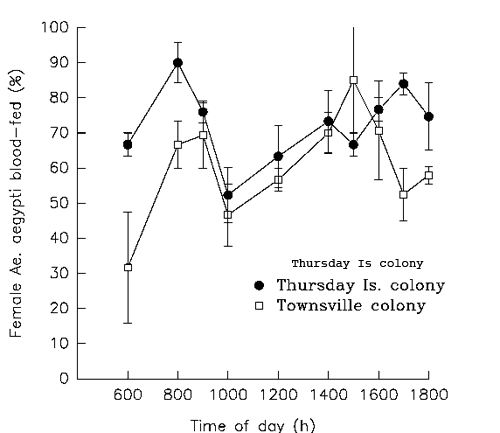
Graph 2. The daily pattern of blood feeding of Aedes aegypti females from 2 colonies showing bimodal diurnal peaks of activity. Figure by L. Perkins.
Sensitivity of the olfactory receptors is modulated by the CNS and hormones. Differential sensitivity is particularly pronounced in female insects that must ‘switch’ between a number of tasks in their life-time, e.g. feeding, mating, egg-laying.
Male moths often have large antennae that carry up to 40,000 ORNs for the same 2 or 3 classes of female sex pheromone Ors. Usually there are 2, but sometimes 3, ORNs that co-compartmentalize within one sensillum. This increases the chance of detecting the weak signal emitted by females, and allows for very fast interaction between neuronal signals before the signals reach the antennal lobe and the CNS.
Above: Antheraea polyphemus adult female taken by Shawn Hanrahan, Texas A&M Insect Collection in College Station, Texas Right: Antheraea polyphemus adult male taken by Shawn Hanrahan, Texas A&M Insect Collection in College Station, Texas |
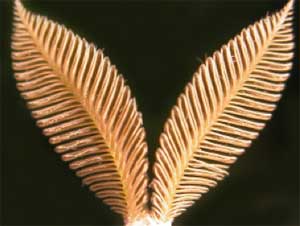 |
In female moths, ORNs tuned to plant compounds appear to replace pheromone-sensitive ones, consequently, small sets of moth OR genes show female-specific expression. During mating and sperm transfer, the male moth passes a substance to the female that inhibits biosynthesis of sex pheromone by the female thus discouraging mating with another male.
Specificity:
Moth sex pheromones epitomize the development of a very sensitive and fine-tuned communication system. Individual ORNs can be sensitive to single molecules of pheremone. The majority of moth sex pheromones are blends of 10- to 18-carbon-long unbranched primary alcohols, acetates, or aldehydes, emitted from the female pheromone gland. Species-specific structural differences are imparted by one or more double bonds inserted at specific locations.
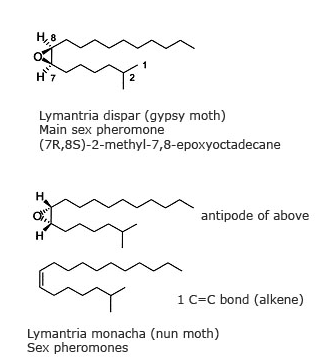 |
The nun moth pheremones are antagonistic to mate-seeking gypsy moths even though the pheromone structures differ little. Redrawn from Honson, et al (2003) Chemical Senses 28: 479-489;doi:10.1093/chemse/28.6.479 |
Species specificity is achieved even if females emit only simple blends of 2 or sometimes 3 pheromone components by emitting the components in precise ratios (along with other behaviourally inert compounds). Additional specificity is achieved by the male moth being broadly sensitive to pheromone components from other species; orientation to a pheromone source is abruptly stopped if the male perceives a compound from a non-conspecific female.
While pheromones are secondary metabolites produced from specific glands within the insect, many odours that insects respond to are generated from the primary metabolism of their hosts (or associated micro-organisms). Such is the case for mosquitoes and the host odours they use to locate a blood meal. Detection of some of these odours appears widespread across insect species. For example, carbon dioxide (CO2) is an atmospheric gas at relatively high concentrations for an odour. Insects in general are sensitive to small fluctuations around ambient concentrations (ca. 0.03%) and mosquitoes detect the CO2 in host breath. CO2 is commonly found to be an ‘activator’; meaning that is elicits take-off (the 1st step in olfactory orientation) and enhances OR sensitivity to other odours. Odours from sweat, blood and the metabolites of skin bacteria are also used by mosquitoes to locate hosts. These odours are complex mixtures of many individual chemicals, and compared to pheromone systems, are much more variable. Host chemicals known to attract some mosquito species, at some concentrations, some of the time, include lactic acid, ammonia, amino acids, and octenol. A single ORN may be sensitive to more than 1 volatile compound meaning it contains more than 1 Or. In mosquitoes, this appears to be the more prevalent type of sensilla trichodea ORN. Both the intensity and the timing of the neuronal response may also play a role in identifying the volatile compound at the CNS level of organization. Higher brain centers have the opportunity to compare among the glomeruli, not only the presence or absence of activity but also the intensity and timing of the activity in order to assess the quality of the odor blend stimulus. This form of odor coding is termed across-fiber patterning and appears to be an essential component in complex odor discrimination.
Once an odour from a resource of interest has been detected by the insect at the appropriate stage of its life-cycle, changes in the physiology of the sensory and neural system lead to the initiation of some behavioural mechanism that ensures the insect locates the source of the odour. It is important to remember that physiologically-relevant odours usually occur within a background of other environmental stimuli, including other odours, tactile and visual cues. Often it is a combination of stimuli that leads to successful orientation to an odour source.
 Go on to Part 2: Behavioural mechanisms
Go on to Part 2: Behavioural mechanisms
Glossary:
CNS Central nervous system, principally the brain.
conspecific insect of the same species.
gravid female with eggs.
hormone Chemicals produced by the insect which circulate in the hemolymph to regulate its long term physiological, developmental and behavioural activities. They compliment and are closely linked to the CNS.
ORN odour receptor neurone. See Topic 13: Sensing taste and odours.
volatile a chemical that is readily vapourised at ambient temperature.
Ors olfactory receptors within the dendrite membrane, see Module: Sensing Taste & Odours for further explanation.
cue a sensory stimulus that causes a behavioural response by the insect.


 Mini-lecture:
Mini-lecture: